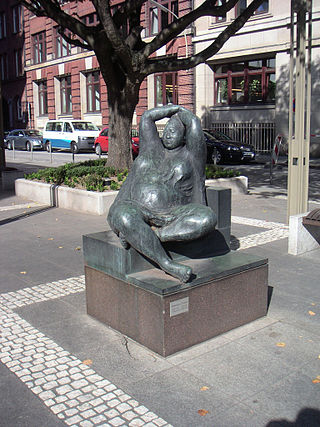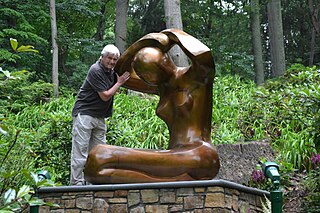This article has multiple issues. Please help improve it or discuss these issues on the talk page . (Learn how and when to remove these template messages)
|
Ignacio Asúnsolo (1890–1965) was a Mexican sculptor trained in France.
This article has multiple issues. Please help improve it or discuss these issues on the talk page . (Learn how and when to remove these template messages)
|
Ignacio Asúnsolo (1890–1965) was a Mexican sculptor trained in France.
Ignacio Asúnsolo was born on March 15, 1890, in the Hacienda de San Juan Bautista ranch in the state of Durango, Mexico. He was the son of Fernando Asúnsolo and Carmen Mason Bustamante. His family moved to Hidalgo de Parral in the state of Chihuahua, where at age 6 he starts modelling clay, an art his mother practised. By 1904 he was studying at the Scientific and Literary Institute of Chihuahua. In 1908 he entered the National Institute of Fine Arts and Literature where he was awarded his first professorship.
Asúnsolo participated in the Mexican revolution from 1913 to 1917, mainly through artistic expression. In 1915, because of a temporary shutdown of the National Institute of Fine Arts, he went back to Chihuahua to teach sculpting at the Scientific and Literary Institute. He returned to Mexico City by 1918.
In 1919, he was awarded a scholarship which allowed him to go to Europe to enhance his skills. In France he studied at Paris' L'Ecole des Beaux-Arts and met Mireille Marthe Barany, whom he married on June 23, 1921. At his return to Mexico, secretary of public education José Vasconcelos invited him to be part of his cultural project, where he makes his first grand format sculptures at the Secretariat's central courtyard. By 1922 he had the sculpting professorship of the National Institute of Fine Arts, and he was awarded the project for the making of the Monumento a la Patria, at the Pérgolas Garden of the Chapultepec Castle. Direction of ENAP and creation of the Civil Association of Mexican Sculptors From 1949 he served as Director of the ENAP (now Faculty of Arts and Design). Five years later, he is reunited with many Mexican sculptors including Francisco Marín, Luis Albarrán y Pliego, Federico Canessi, and Ernesto Tamariz; the intention being to form a society protecting the interests of Mexican sculptors without interfering with the authentic foreign values that were introduced into Mexican culture by the works of Francisco Zúñiga and Rodrigo Arenas Betancourt. The Civil Association of Mexican Sculptors is created in February and Asúnsolo is appointed general secretary.
Ignacio Asúnsolo died at 10:30 a.m. on December 22, 1965, suffering from a cardiac arrest. His funeral was attended by important characters such as David Alfaro Siqueiros, Rufino Tamayo, Miguel Alemán, Justino Fernández, and Guadalupe Rivera Marín, among others. Influences All along his career, Asúnsolo showed a style influenced by classical art and his mentors Maillol, Mariano Benlliure, Mateo Inurria, Auguste Rodin, Arnulfo Domínguez Bello, and Enrique Guerra, among others. He acquired many of these ideas while he lived in Europe. He was an adept of Formalism.

Felix Weihs de Weldon was an American sculptor. His most famous pieces include the United States Marine Corps War Memorial in the Arlington National Cemetery, Virginia, US, and the Malaysian National Monument (1966) in Kuala Lumpur.

Gaston Lachaise was a French-born sculptor, active in the early 20th century. A native of Paris, he was most noted for his female nudes such as Standing Woman. Gaston Lachaise was taught the refinement of European sculpture while living in France. He met a young American woman, Isabel Dutaud Nagle, and the pair moved to America, where his craft reached maturity and he was influenced and inspired by American ways. Lachaise helped redefine the female nude in a new and powerful manner. His drawings also reflected his new style of the female form.

Evelyn Beatrice Longman was a sculptor in the U.S. Her allegorical figure works were commissioned as monuments and memorials, adornment for public buildings, and attractions at art expositions in early 20th-century America. She was the first woman sculptor to be elected a full member of the National Academy of Design in 1919.

José Jesús Francisco Zúñiga Chavarría was a Costa Rican-born Mexican artist, known both for his painting and his sculpture. Journalist Fernando González Gortázar lists Zúñiga as one of the 100 most notable Mexicans of the 20th century, while the Encyclopædia Britannica calls him "perhaps the best sculptor" of the Mexican political modern style.

Antun Augustinčić was a Croatian sculptor active in Yugoslavia and the United States. Along with Ivan Meštrović and Frano Kršinić, he is considered one of the three most important Croatian sculptors of the 20th century. His most notable sculptures include the Peace monument which stands in front of the United Nations building in New York City, the Miner statue in front of the International Labour Organization headquarters in Geneva, and the sculpture of Yugoslav president Josip Broz Tito, present in several copies throughout former Yugoslavia.

Sergio Andres Peraza Avila is an artist sculptor from Mexico.

Sebastián is a Mexican sculptor best known for his monumental works of steel and/or concrete in both Mexico and abroad. These include a number of “gate” sculptures such as the Gran Puerta a México in Matamoros, Tamaulipas but his most famous sculpture is the “Caballito” located in downtown Mexico City. His works are found in various countries outside Mexico, such as Japan where two are now used as city symbols.
Luis Ortiz Monasterio was a Mexican sculptor noted for his monumental works such as the Monumento a la Madre and the Nezahualcoyotl Fountain in Chapultepec Park. His work was recognized in 1967 with the Premio Nacional de Artes and was a founding member of the Academia de Artes.

Jorge Marín is a Mexican sculptor and painter. He has been an active figure in the contemporary art world for the last 25 years. He began to sculpt ceramic in the early 1980s. Bronze has been his preferred material for the last ten years. His work often depicts horses, centaurs, garudas, children, madonnas, acrobats, along with elements such as spheres, masks, wings, arrows, boats and scales. These concepts are consistent with recurring themes such as reflection and balance.
Luis Y. Aragón is a Mexican painter and sculptor, best known for his sculpted mural work, as well as the design of the Gawi Tonara award which is given by the state of Chihuahua. His mural work can be found in various parts of Mexico, especially his home state of Chihuahua and Mexico City. His work has been exhibited in Mexico and abroad, generally in the Americas and Europe. He is a member of the Salón de la Plástica Mexicana and works in Mexico City.

Deyanira África González Melo is a Mexican sculptor who generally works in ceramics, depicting elements of the human form, especially the torso, generally with mutilations and other disturbing elements to dispute the otherwise traditional and sensual depictions of the human body. She has exhibited her work since studying at the Escuela Nacional de Artes Plásticas (ENAP) in Mexico as well as in Europe and the Caribbean. Her work has received recognition in Mexico and abroad, and is a member of the Salón de la Plástica Mexicana.

Tome Serafimovski was a Macedonian sculptor, author of more than 500 sculptures of durable materials – wood, bronze and marble – 100 miniatures, as well as 40-odd notable monuments across the country and around the world. He became a member of the Macedonian Academy of Sciences and Arts in 1988. During 50-year career he held several solo exhibitions in Macedonia and abroad, and won a number of awards and accolades.

Fernando González Gortázar was a Mexican architect, sculptor, and writer, considered to be one of the most influential Mexican architects of the 20th century.

Victorio Macho was a renowned 20th-century Spanish sculptor. He is considered to be one of the greats of modern Spanish sculpture. His style was influenced by art deco. His home and workshop in Toledo was converted into a museum dedicated to his work, the Victorio Macho Museum, after his death. He has been featured on a postage stamp of Spain.

Ruth María Rivera Marín was a Mexican architect. Her professional experience centered on teaching, institutional management, theory and practice related to architecture. She was the first woman student of the College of Engineering and Architecture at the National Polytechnic Institute.

Mark Yale Harris is an American sculptor, and a former businessperson. He is working primarily in stone and bronze for his art. Beginning his professional life in the business sector, in 1972 Harris co-founded and was executive vice president of Red Roof Inns. In 1991, he founded AmeriSuites Hotels, where he served as CEO. He lives and works in the Roaring Fork Valley region of Colorado.
Gaspar Enriquez is an American artist known for creating photorealist portraits, primarily of people of Chicano heritage. He uses the airbrush technique in his paintings. Enriquez is also a sculptor and a jewelry maker who works in metal.

Sculpture is one of the oldest arts in Mexico. In Prehispanic Mexico, it is present in pyramids, sanctuaries, esplanades and communal objects; examples of this are the Olmec, Mayan, Teotihuacan, Tarascan, Mixtec and Aztec sculptures.

Joaquín Bilbao Martínez was a Spanish sculptor. The equestrian statue of Ferdinand III of Castile in the Plaza Nueva, Seville, opposite the Town Hall, was sculpted by him.

Marin Vasilev Selovlev, known professionally as Marin Vasilev was a Bulgarian sculptor and art professor. Together with Boris Schatz and Zheko Spiridonov, he is considered to be a founding figure of modern Bulgarian sculpture.